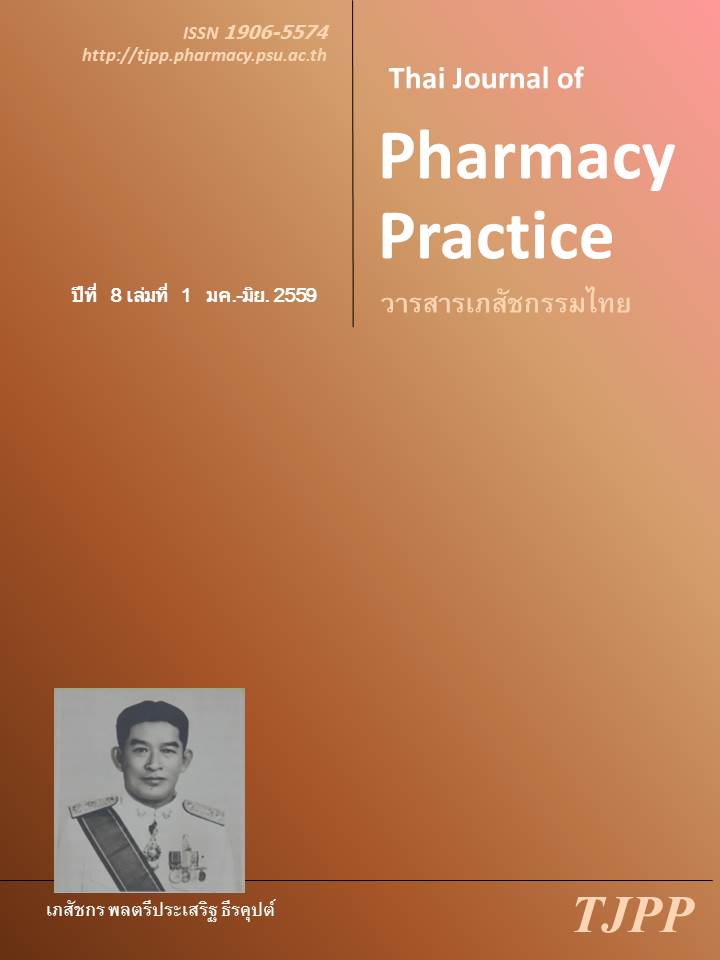การจัดการปัญหาการใช้ยาของผู้ป่วยโรคเรื้อรังที่บ้านโดย เภสัชกรครอบครัวในเครือข่ายบริการสุขภาพอำเภอกระนวน
Main Article Content
บทคัดย่อ
วัตถุประสงค์: การศึกษานี้เป็นการวิจัยเชิงพรรณนาเพื่อศึกษาชนิดของปัญหาที่เกี่ยวกับยา สาเหตุ วิธีการแก้ไข และผลลัพธ์ของการแก้ไขปัญหาในผู้ป่วยที่ได้รับการเยี่ยมบ้านโดยเภสัชกรครอบครัวของโรงพยาบาลสมเด็จพระยุพราชกระนวน และสังเคราะห์แนวทางการแก้ไขปัญหาการใช้ยาที่ใช้ได้ผล วิธีการ: เก็บข้อมูลช่วงปีงบประมาณ 2556-2557 โดยใช้แบบบันทึกการเยี่ยมบ้าน เภสัชกรครอบครัวค้นหาปัญหาการใช้ยาและประเมินผลลัพธ์ของการแก้ปัญหาด้วยวิธีการสัมภาษณ์ข้อมูลและสังเกตผู้ป่วย การจัดกลุ่มประเภทของปัญหาที่เกี่ยวกับยา สาเหตุ วิธีการแก้ไข และผลลัพธ์ใช้แนวทางของ The Pharmaceutical Care Network Europe (PCNE) วิเคราะห์ผลด้วยสถิติเชิงพรรณนา ผลการวิจัย: จากผู้ป่วยที่มีข้อมูลสมบูรณ์ทั้งหมด 109 คน พบว่า ส่วนใหญ่เป็นเพศหญิง (ร้อยละ 65.14) อายุเฉลี่ย 65.21±12.74 ปี โรคเรื้อรัง 3 อันดับแรก ได้แก่ เบาหวาน (ร้อยละ 77.98) ความดันโลหิตสูง (ร้อยละ 62.39) และโรคระบบหัวใจและหลอดเลือด (ร้อยละ 28.44) ผู้ป่วยได้รับการเยี่ยมบ้านเฉลี่ยคนละ 2.11±1.92 ครั้ง (สูงสุด=14, ต่ำสุด=1) ปัญหาการใช้ยาที่พบมากที่สุด คือ ผู้ป่วยไม่รับประทานยาหรือไม่ใช้ยาในทุกกรณี (ร้อยละ 53.06) สาเหตุของปัญหาส่วนใหญ่ คือ การใช้ผลิตภัณฑ์สุขภาพอื่นร่วมด้วย (ร้อยละ 18.87) วิธีการแก้ปัญหาที่ใช้บ่อย คือ การให้คำแนะนำโดยวาจาแก่ผู้ป่วย (ร้อยละ 30.77) และวิธีการอื่น ๆ (ร้อยละ 33.03) เช่น การเสริมศักยภาพผู้ดูแล การจัดหาอุปกรณ์ที่ช่วยในการใช้ยา อย่างไรก็ตามปัญหาการใช้ยาบางส่วนก็ไม่สามารถจัดการได้อย่างสมบูรณ์ทั้งนี้อาจเกิดจากข้อจำกัดของตัวผู้ป่วยเองและผู้ดูแล สรุป: ปัญหาการใช้ยาในผู้ป่วยโรคเรื้อรังในชุมชนมีสัดส่วนที่สูง การเยี่ยมบ้านของเภสัชกรครอบครัวเป็นส่วนหนึ่งที่จะช่วยแก้ไขปัญหานี้ได้
Article Details
ผลการวิจัยและความคิดเห็นที่ปรากฏในบทความถือเป็นความคิดเห็นและอยู่ในความรับผิดชอบของผู้นิพนธ์ มิใช่ความเห็นหรือความรับผิดชอบของกองบรรณาธิการ หรือคณะเภสัชศาสตร์ มหาวิทยาลัยสงขลานครินทร์ ทั้งนี้ไม่รวมความผิดพลาดอันเกิดจากการพิมพ์ บทความที่ได้รับการเผยแพร่โดยวารสารเภสัชกรรมไทยถือเป็นสิทธิ์ของวารสารฯ
เอกสารอ้างอิง
2. National Health Security Office Area 7 Khon Kaen. A handbook of developing primary care system Fiscal Year 2014. Khon Kaen: National Health Security Office Area 7 Khon Kaen, 2014.
3. Ministry of Public Health. Development plan for public health service system (service plan). Nonthaburi: Ministry of Public Health; 2012.
4. Juntrabhibhat K. Policy of primary care pharmacy driven by the National Health Security Office [online]. 2014. [cited 2015 Jul 31] Available from http://www.nhso.go.th/files/userfiles/file/…/DHSคณิตศักดิ์20มีค57.pdf.
5. Department of Pharmacy and Consumer Health Protection, Kranuan Crown Prince Hospital. Report of drug related problems in patients with chronic diseases. Khon Kaen: Kranuan Crown Prince Hospital; 2010.
6. Peterson GM, Fitzmaurice KD, Naunton M, Vial JH, Stewart K. Impact of pharmacist-conducted home visits on the outcomes of lipid-lowering drug therapy. J Clin Pharm Ther 2005; 29: 23-30.
7. Maneerat M, Waleekhachonloet O, Phumart P, Sangasri P. Effect of home health care by pharmacy students on knowledge, compliance, and wasted drug problems in households. Thai Journal of Pharmacy Practice 2010; 2: 24.34.
8. Tunpichart S, Sakulbumrungsil R, Somrongthong R, Hongsamoot D. Chronic care model for diabetics by pharmacist home health in Bangkok metropolitan: a community based study. Int J Med Med Sci 2012; 4: 90-6.
9. Ningsanon T, Monthakarnkul P, Wanakmanee U, Suansanea T, Chatuporn T, editors. Textbook of family pharmacist. Bangkok: The Association of Hospital Pharmacy (Thailand); 2014.
10. Hepler CD, Strand LM. Opportunities and responsibilities in pharmaceutical care. Am J Hosp Pharm 1990; 47:533-43.
11. American Society of Health-System Pharmacists. ASHP guidelines on a standardized method for pharmaceutical care. Am J Health-Syst Pharm 1996; 53:1713–6.
12. Pharmaceutical Care Network Europe Foundation. PCNE classification for drug related problems (revised 01- 05-06 vm) V 5.01 [online]. 2006. [cited 2015 Jul 31]. Available from: http://www. pcne.org/upload/files/16_PCNE_classification_V5.01.pdf
13. Hanrinth R. Classification for drug related problems. Thai Journal of Pharmacy Practice 2009 ; 1: 84-95.
14. Thaungsuwan W, Jedsadayanmata A. Effect of pharmacist participation in multidisciplinary team for home visit on blood pressure and drug adherence of stroke patients. Thai Journal of Pharmacy Practice 2016; 8: 48-57.
15. Fiß T, Meinke-Franze C, van den Berg N, Hoffmann W. Effects of a three party healthcare network on the incidence levels of drug related problems. Int J Clin Pharm 2013; 35:763–71.
16. Pharmaceutical Care Network Europe Foundation. PCNE classification for drug related problems (revised 14-01-2010 vm) V 6.2 [online]. 2010. [cited 2015 Jul 31]. Available from: http://www. pcne.org/upload/files/11_PCNE_classification_V6-2.pdf.
17. Adusumilli PK, Adepu R. Drug related problems: an overview of various classification systems. Asian J Pharm Clin Res 2014; 7: 7-10.
18. Van Mil, F. Drug-related problems: a cornerstone for pharmaceutical care. Journal of the Malta College of Pharmacy Practice 2005; 10: 5-8.
19. World Health Organisation. WHO Guidelines on hand hygiene in health care: first global patient safety challenge clean care is safer care [online]. 2009. [cited 2016 Mar 20]. Available from: http://www.ncbi.nlm.nih.gov/books/NBK144022/.


